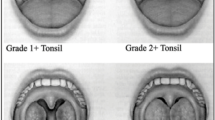Abstract
Purpose
Chronic upper airway obstruction caused by adenotonsillar hypertrophy is one of the major cause of morbidity in children. It can lead to Obstructive Sleep Apnoea Syndrome, Pulmonary Hypertension, Cor Pulmonale and right heart failure. The study aimed to evaluate and compare various parameters of cardiac function with the help of echocardiography preoperatively and postoperatively in children undergoing adenotonsillectomy.
Methodology
A prospective cohort study was conducted on 23 patients at an apex care institute, under the age group of 4–12 years, who were diagnosed with adenotonsillar hypertrophy. Preoperative symptom analysis and Echocardiographic examination were done. After the assessment, all patients underwent surgery in the form of adenotonsillectomy. Follow-up symptom analysis and echocardiographic examination was done after 3 months postoperatively.
Results
Significant improvement in the obstructive symptoms were noted in postoperative group as expected (p = < 0.001) and also in parameters such as mPAP (p = < 0.001), TAPSE (p = < 0.001), TAV (p = 0.001), Ejection fraction (p = 0.027) and RVMPI (p = 0.044) were improved in postoperative group. 4 patients had Grade 1 Right ventricular diastolic dysfunction, which disappeared in three patients postoperatively.
Conclusion
We have concluded that there can be subclinical cardiac dysfunctions which occurs as a result of chronic upper airway obstruction due to untreated adenotonsillar hypertrophy. Routine cardiac screening in children presenting with sleep disordered breathing associated with adenotonsillar hypertrophy may be helpful in identifying and preventing the development of cardiopulmonary complication. These changes can be reversed by performing adenotonsillectomy.

Similar content being viewed by others
References
Li H-Y, Lee L-A (2009) Sleep-disordered breathing in children. Chang Gung Med J 32:247–257
Kaditis AG, Alonso Alvarez ML, Boudewyns A et al (2016) Obstructive sleep disordered breathing in 2- to 18-year-old children: diagnosis and management. Eur Respir J 47:69–94
Attia G, Ahmad MA, Saleh AB et al (2010) Impact of obstructive sleep apnea on global myocardial performance in children assessed by tissue Doppler imaging. Pediatr Cardiol 31:1025–1036
Rosenzweig EB, Widlitz AC, Barst RJ (2004) Pulmonary arterial hypertension in children. Pediatr Pulmonol 38:2–22
Barst RJ, Ertel SI, Beghetti M et al (2011) Pulmonary arterial hypertension: a comparison between children and adults. Eur Respir J 37:665–677
Dandel M, Lehmkuhl H, Knosalla C et al (2009) Strain and strain rate imaging by echocardiography—basic concepts and clinical applicability. Curr Cardiol Rev 5:133–148
Chan J, Edman JC, Koltai PJ (2004) Obstructive sleep apnea in children. Am Fam Physician 69:1147–1154
Ng SK, Lee DLY, Li AM et al (2010) Reproducibility of Clinical grading of tonsillar size. Arch Otolaryngol Neck Surg 136:159
Sharifkashani S, Dabirmoghaddam P, Kheirkhah M et al (2015) A new clinical scoring system for adenoid hypertrophy in children. Iran J Otorhinolaryngol 27:55–61
Chan JYS, Li AM, Au C-T et al (2009) Cardiac remodelling and dysfunction in children with obstructive sleep apnoea: a community based study. Thorax 64:233–239
Sevimli S, Gundogdu F, Aksakal E et al (2007) Right ventricular strain and strain rate properties in patients with right ventricular myocardial infarction. Echocardiography 24:732–738
Miman MC, Kirazli T, Ozyurek R (2000) Doppler echocardiography in adenotonsillar hypertrophy. Int J Pediatr Otorhinolaryngol 54:21–26
Çetin M, Yılmaz M, Özen S et al (2014) Assessment of pulmonary artery pressure and right ventricular function in children with adenotonsillar hypertrophy using different parameters. Int J Pediatr Otorhinolaryngol 78:1837–1842
Kjaergaard J, Akkan D, Iversen KK et al (2007) Right ventricular dysfunction as an independent predictor of short- and long-term mortality in patients with heart failure. Eur J Heart Fail 9:610–616
Lee JH, Yoon JM, Lim JW et al (2014) Effect of adenotonsillar hypertrophy on right ventricle function in children. Korean J Pediatr 57:484
Tatlipinar A, Duman D, Uslu C et al (2011) The effects of obstructive sleep apnea syndrome due to adenotonsillar hypertrophy on the cardiovascular system in children. Turk J Pediatr 53:359–363
Kang SJ, Kwon YW (2018) Right atrial deformation mechanics in children with adenotonsillar hypertrophy. J Cardiovasc Imaging 26:201
Koc S, Aytekin M, Kalay N et al (2012) The effect of adenotonsillectomy on right ventricle function and pulmonary artery pressure in children with adenotonsillar hypertrophy. Int J Pediatr Otorhinolaryngol 76:45–48
Tezer MS, Karanfil A, Aktaş D (2005) Association between adenoidal–nasopharyngeal ratio and right ventricular diastolic functions in children with adenoid hypertrophy causing upper airway obstruction. Int J Pediatr Otorhinolaryngol 69:1169–1173
Tal A, Leiberman A, Margulis G et al (1988) Ventricular dysfunction in children with obstructive sleep apnea: radionuclide assessment. Pediatr Pulmonol 4:139–143
Mirecka J, Mazurek-Kula A, Ostrowska K et al (2019) Left heart ventricle function in children snoring due to adeno-tonsillar hypertrophy. Pediatr Pol 94:13–17
Acknowledgements
We thank Dr. Prem Prakash Sharma (Associate Professor, Department of Community Medicine and Family Medicine) for his tremendous help in statistical analysis of the data.
Funding
No funding was received to conduct this study or with the preparation of manuscript.
Author information
Authors and Affiliations
Contributions
All authors certify that they have no affiliations or involvement in any organization or entity with any financial or non-financial interest in the subject matter or materials discussed in this manuscript.
Corresponding author
Ethics declarations
Conflict of interest
The authors have no conflicts of interest to declare that are relevant to the content of this article.
Ethical approval
Ethical approval for this study was obtained from Institutional Ethical Committee, AIIMS Jodhpur vide their letter number No. AIIMS/IEC/2018/1440. There was no extra financial burden for the patients in relation to study.
Consent to participate
All parents of the patients were informed about the purpose of the study before enrolling. Informed written consent was taken from parents or caretakers of all the children included in the study.
Additional information
Publisher's Note
Springer Nature remains neutral with regard to jurisdictional claims in published maps and institutional affiliations.
Rights and permissions
About this article
Cite this article
Sameema, V.V., Soni, K., Deora, S. et al. Assessment of preoperative and postoperative cardiac function in children with adenotonsillar hypertrophy: a prospective cohort study. Eur Arch Otorhinolaryngol 279, 3013–3019 (2022). https://doi.org/10.1007/s00405-022-07255-4
Received:
Accepted:
Published:
Issue Date:
DOI: https://doi.org/10.1007/s00405-022-07255-4




